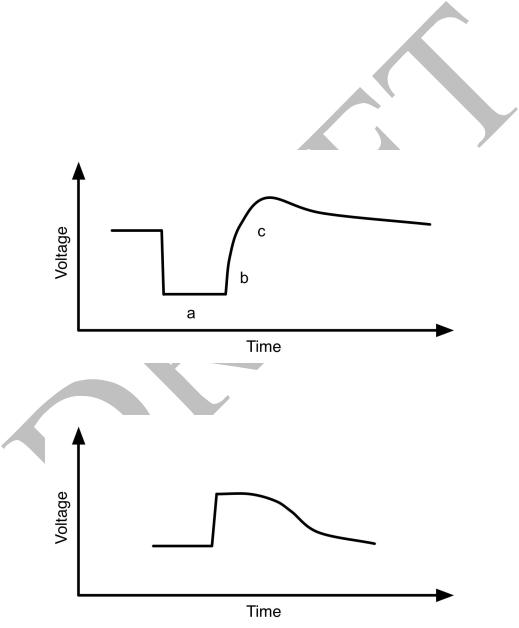
IAEA Design of Electrical Power Systems for Nuclear Power Plants
.pdf
a. When the AC input voltage goes low during fault clearing on the supply side and returns to a high voltage.
When clearing faults on the transmission system close to the plant, typical duration is 100 – 250 ms, and when faults happen in the on-site power system the typical duration is up to 100 ms. After a fault on the grid is cleared, the supply voltage will rise to a level determined by the generator acting as supply. (See Fig. 7.) This voltage sag and swell with short rise time might cause severe overvoltage on the DC side of a battery charger.
An effective way is to automatically, with no time delay, shut down the battery charger on AC undervoltage and restart when the supply voltage is normal. This might shield the DC (and uninterruptible AC) power systems from voltage transients induced from grid events.
b.In loss of load scenarios when the input voltage goes high.
The voltage rise will be determined by the previous active and reactive loading of the generator. The overvoltage will typically be 130–150 %. (See Fig. 8)
FIG. 7. Typical on-site voltage profile during clearing of transmission system fault, a. Voltage during fault, b. Rapid voltage rise, c. Voltage swell due to generator excitation and return to normal voltage.
FIG. 8. Typical on-site voltage profile after loss of load (transfer to house load operation).
7.101. Battery chargers should be able to supply the loads without any battery connected.
7.102. The ability to supply DC loads directly from the battery charger is part of the diversity in power
supply of DC systems. Operation in this mode is not normally expected.
66

7.103. Each battery charger should have disconnecting devices in the AC and DC circuits to enable the battery charger to be isolated.
Uninterruptible AC power system
7.104. Uninterruptible AC safety power systems should be provided where necessary to supply loads for equipment important to safety that requires continuous AC power.
7.105. Some plant designs will not need uninterruptible AC power systems. With modern I&C systems it is feasible to power all loads requiring continuous power with DC. Such an approach eliminates a source of failure.
7.106. Each division of an uninterruptible AC safety power system should consist of a power supply from a DC safety power system to an inverter, a power supply from the AC bus of the same division, and a device for automatically switching between the two supplies.
7.107. Alternatively the uninterruptible AC safety power supply may be in the form of an uninterruptible power supply with dedicated battery charger, battery and inverter.
7.108. If an uninterruptible power supply is used, the guidance given here for battery chargers and batteries also applies.
7.109. The electrical characteristics and the continuity of the uninterruptible AC power supply should meet the design requirements of the loads to be served by the system.
7.110. The limiting case for capacity is normally station blackout.
7.111. An uninterruptible power supply might experience a perturbation in its output, such as voltage sag or an interruption to the cycle, provided that such a perturbation does not result in a loss of the required function of the equipment being served by the supply or in any undesired action by the equipment.
7.112. The design of uninterruptible power supplies should be consistent with the characteristics and design requirements of the loads and the interactions between loads connected to the uninterruptible AC system.
7.113. For example, the design of static inverters should ensure that the voltage harmonics produced by the inverter itself, as well as by any non-sinusoidal loads, do not degrade the functions of the systems being supplied.
Protection of DC power systems and uninterruptible AC power system
7.114. Battery chargers, inverters and motor generator sets are sources of limited short-circuit current. This will affect the sensitivity requirements for their protective devices.
67

7.115. The protection for battery chargers, inverters, and motor generator sets should be coordinated with their associated alternative supplies, inverters, static switches, battery chargers, distribution panels, instrumentation panels and racks, and other equipment that they power.
7.116. The DC power and uninterruptible AC power systems should be provided with undervoltage and overvoltage protection.
7.117. Ground detection monitoring should be provided for isolated (ungrounded) DC power systems.
7.118. The ground detection monitoring is to give an alarm before the impedance to ground falls below a value at which any malfunctions could occur.
7.119. The DC power distribution system should be provided with coordinated protection.
7.120. Coordination for DC power system circuits involves main bus protective devices and the protective devices used in branch circuits, in switchgear control circuits, in relay and process control panels, and in battery chargers.
7.121. In performing coordination analysis of DC protective devices it is necessary to use appropriate correction factors or DC trip characteristic curves for protection devices.
7.122. The uninterruptible AC safety power system should be provided with coordinated protection.
7.123. Coordination involves the main bus protective devices and the protective devices used in branch circuits.
7.124. The battery charger, the battery, and the inverter (or motor generator set) is a functional unique system because these elements create the “power supply chain” for many uninterruptible loads and have strong interactions among them. Consequently, properly coordinated protection settings will preserve the safety functions. For example, in case of overvoltage on the AC supply to the battery charger, the battery charger will limit the transfer of the disturbance to the DC side to a level that would not cause trip of other safety loads – including the uninterruptible power supply itself.
7.125. Uninterruptible AC power systems should be provided with underfrequency and overfrequency protection.
8.ALTERNATE AC POWER SUPPLIES
8.1.An alternate AC power supply should be provided at or near the plant if the plant’s design depends upon AC power to bring the plant to a controlled state following loss of offsite power.
8.2.Alternate AC power supplies are provided to protect the electrical systems against the simultaneous failure of off-site and emergency AC power supplies. This involves AC power sources that are diverse in design and not susceptible to the events that caused the loss of on-site and off-site power sources.
8.3.The alternate AC power supplies with auxiliaries should be qualified for its intended application.
68

8.4.Alternate AC power supplies should have sufficient capacity to operate systems necessary for coping with a station blackout for the time required to bring the plant to and maintain it in a controlled state.
8.5.Ensuring that the alternate AC power supplies can cope with station blackout involves ensuring that the alternate supply is sufficient for simultaneous removal of reactor decay heat, ensuring primary circuit integrity, maintaining the reactor sub-critical, and for removing decay heat from spent fuel for all served units for a period of time that is sufficient for reliable restoration of other power sources.
8.6.Units that have more than the required redundancy of standby AC power sources may use one of these sources for an AAC source, provided that it meets the other criteria of this section.
8.7.If an alternate AC power source serves more than one unit at a site where safety standby AC power sources are shared between units, the alternate AC power source should have sufficient capacity to operate systems necessary for coping with a station blackout for the time required to bring all units that share the safety AC power sources to, and maintain them in a controlled state.
8.8.The alternate AC power source for one unit should not normally be connected to the on-site power system of that unit.
8.9.Support systems that maintain the AAC source in readiness may be powered from one or more units, providing it does not affect the operability of the alternate AC power source.
8.10.There should be a minimum potential for common cause failure of any safety Standby AC Power Source and the alternate AC power source.
8.11.No single point of vulnerability should exist whereby a weather related event, external event, or single active failure could disable any of a unit’s safety standby AC power supply and simultaneously fail all off-site power supplies and the alternate AC power supplies.
8.12.Provisions should be made for connecting the alternate AC power supply to one or all safety power system buses.
8.13.The safety power systems should be fed from the alternate AC power supply only after it has been disconnected from other power supplies.
8.14.The alternate AC power supply may also have the capability to power certain loads necessary from defence in depth aspects.
8.15.Alternate AC power supplies should be capable of supplying the required loads within the time specified in the plant safety analysis and the plant station blackout coping analysis.
8.16.Preferably the Alternate AC power supplies will be capable of supplying loads as soon as is reasonably practicable. Restoring AC power as soon as possible after a station blackout restores a degree of defence in depth to the electrical power systems, restores safety systems that depend on AC
69

power, and restores support systems (e.g., lighting and habitability systems) that significantly enhance the operators’ ability to respond to an event.
9. DESIGN CONFIRMATION AND DOCUMENTATION
MANAGEMENT SYSTEM
9.1. The design of electrical systems important to safety should be conducted within the framework of an overall management system that meets the requirements of GS-R-3, Ref. [14] and follow the recommendations of GS-G-3.1, Ref. [15], and GS-G-3.5, Ref. [16].
VERIFICATION
9.2.The capacity and capability required of electrical power systems should be determined by analysis and verified by tests. (Refer to annex II.)
9.3.As part of the design and design verification, the following should be performed and documented in a form suitable for auditing:
a.Demonstration that the electrical power systems are capable of fulfilling their safety functions as set out in their design bases;
b.Demonstration that the electrical power systems design requirements are met;
c.Demonstration that electrical safety power systems comply with the single failure criteria;
d.Demonstration that electrical power systems meet design basis reliability requirements;
e.Demonstration that operation of protective devices have been adequately coordinated;
f.Demonstration that adequate mitigating measures against station blackout are implemented;
g.Demonstration that the reliability of off-site circuits credited with supplying safety loads meets and will continue to meet availability requirements after planned changes to transmission and generation facilities;
h.Demonstration that the off-site circuits credited with supplying safety loads will continue to have their required capacity and capability in the presence of: loss of the nuclear plant, loss of the largest generating unit, loss of the largest transmission circuit or intertie, or loss of the largest load.
i.Demonstration that each offsite power supply has the capacity and capability to power all electrical loads required to mitigate the consequences of all design basis accidents and anticipated operational occurrences.
9.4.The demonstration should cover all modes of operation of the nuclear plant.
9.5.The demonstration of the off-site circuits’ reliability and availability should be performed together with the transmission system operator. (Refer to Section 6.)
9.6.For all systems important to safety a systematic assessment should be conducted to confirm that the design achieves the reliability requirements of the system design basis.
70

9.7.This demonstration may be based on a balance of application of deterministic criteria and quantitative reliability analysis that considers design features such as, for example, redundancy, testability, failure modes, and rigor of qualification.
9.8.The use of software or complex multi-element logic modules might provide difficulties in justification of reliability and sensitivity to common cause failures. The reliability may therefore depend on assurances of freedom from error in the design and implementation process.
9.9.Test facilities that are part of the safety system should be considered when determining system availability.
9.10.Analytical tools used in design and analysis of electrical systems should be qualified and the validity of the mathematical models should be justified on the basis of experimental data or operating experience.
9.11.The analyses recommend by paragraph 9.2–9.10 are part of the plant safety assessment. NS-G- 1.2, Ref. [4] provides additional guidance on safety assessment.
T estin g
9.12.Provisions should be made in the design to ensure that the following test programmes can be implemented without endangering the safety of the plant during testing:
a.A pre-operational test programme to demonstrate operation in all system modes (e.g., operational and emergency) to the extent practicable, to prove that the design requirements have been met, and to establish that each division is independent of other divisions.
b.A test programme during operation that provides adequate assurance of the readiness of the systems to function upon demand.
c.Periodic test procedures to demonstrate the continuing operability of the system and to detect and identify any degradation of the system or components within the system.
9.13.General recommendations on measures for verifying the adequacy of the design are given in GS- G-3.5, Ref. [16] paragraphs 5.114 to 5.134.
9.14.A major consideration of pre-operational test programmes for electrical power systems is to confirm, before entering into operation, and after major modifications, the independence between divisions of the safety power systems. Normally this involves testing to verify that all on-site power systems and their load groups can successfully operate and is in no way affected by the partial or complete failure of any other power source in other divisions.
DESIGN DOCUMENTATION
9.15.Documentation of the electrical power systems should include:
a.Design bases;
b.A description of the overall power supply system including:
1.Details of how the nuclear power plant is connected to the grid,
71

2.An explanation of the degree of redundancy of the electrical safety power system,
3.Identification of interfaces with the auxiliary systems;
c.A description of the separation criteria for installing equipment, cables and raceways, including wiring and components inside panels;
d.One-line diagrams, functional control diagrams, schematic diagrams, connection diagrams, panel wiring diagrams, and descriptions of systems;
e.Layout plans for the on-site electrical power system together with the arrangements of equipment and associated support systems.
f.Layout plans of cable routes, including trays, ducts and conduits, throughout the plant and identification of redundant divisions and cables and their routing;
g.Raceway schedules showing cables contained in each raceway segment and the fill percentage of each segment;
h.Circuit schedules identifying for each field cable its connection points, cable type, and routing through the raceway system;
i.An electrical load analysis showing the inventory of electrical loads and for electrical safety power systems showing a time dependent loading from which the capabilities of the necessary components of the power systems are calculated;
j.Operating procedures and maintenance manuals for electrical power systems and equipment;
k.Periodic test and maintenance requirements for electrical power systems and equipment;
l.Documentation of acceptance and commissioning tests for electrical power systems and equipment;
m.Quality assurance records;
n.Analysis of voltage and frequency transients, short circuit calculations, and voltage drop calculations:
1.From the grid during power operation,
2.From the on-site electrical distribution system,
3.From the grid during shutdown, and
4.From the main generator.
o.Steady state load and voltage profile studies that show the voltages throughout the power system for various modes of plant operation (and generator load/ power factor), including design basis events, at the time of normal and degraded voltage conditions.
p.Transient load and voltage studies that show the profile of the loads that are sequentially applied to the preferred and standby power supplies during various modes of plant operation.
q.A power system study that examines loading and voltages in the DC power systems supplying alternating current and direct current systems during various modes of plant operation.
r.A bus transfer study that analyses the impact of voltage, phase angle, frequency, and the effect of motor reacceleration on buses and motors before, during, and immediately after automatic bus transfers.
72

s.Short-circuit studies to determine the maximum and minimum fault currents throughout the power system for various modes of plant operation, including design basis events, to be used to analyse the fault clearing capability of the electrical equipment.
t.Protective device coordination and equipment protection studies that show proper set point selection in all of the protective schemes;
u.Analysis of fuel storage capacities for standby power sources;
v.Analysis of the consequences of partial or total loss of power supplies;
w.Equipment qualification plans, analyses, and test reports, and
x.Specifications for electrical power components.
73

74

REFERENCES
[1]INTERNATIONAL ATOMIC ENERGY AGENCY, Safety of Nuclear Power Plants: Design, IAEA Safety Standards Series No. SSR-2/1, IAEA, Vienna (2012).
[2]INTERNATIONAL ATOMIC ENERGY AGENCY, Design of Emergency Power Systems for Nuclear Power Plants, Safety Standards Series No. NS-G-1.8, IAEA, Vienna (2004).
[3]INTERNATIONAL ATOMIC ENERGY AGENCY, Design of Instrumentation and Control Systems for Nuclear Power Plants, Safety Standards Series No. DS431, IAEA, Vienna (Draft 03 August 2011).
[4]INTERNATIONAL ATOMIC ENERGY AGENCY, Safety Assessment and Verification for Nuclear Power Plants, Safety Standards Series No. NS-G-1.2, IAEA, Vienna (2001).
[5]INTERNATIONAL ATOMIC ENERGY AGENCY, External Events Excluding Earthquakes in the Design of Nuclear Power Plants, Safety Standards Series No. NS-G-1.5, IAEA, Vienna (2003).
[6]INTERNATIONAL ATOMIC ENERGY AGENCY, Seismic Design and Qualification for Nuclear Power Plants, Safety Standards Series No. NS-G-1.6, IAEA, Vienna (2003).
[7]INTERNATIONAL ATOMIC ENERGY AGENCY, Protection against Internal Fires and Explosions in the Design of Nuclear Power Plants, Safety Standards Series No. NS-G-1.7, IAEA, Vienna (2004).
[8]INTERNATIONAL ATOMIC ENERGY AGENCY, Protection against Internal Hazards other than Fires and Explosions in the Design of Nuclear Power Plants, Safety Standards Series No. NS-G-1.11, IAEA, Vienna (2004).
[9]INTERNATIONAL ATOMIC ENERGY AGENCY, Operational Limits and Conditions and Operating Procedures for Nuclear Power Plants, Safety Standards Series No. NS-G-2.2, IAEA, Vienna (2000).
[10]INTERNATIONAL ATOMIC ENERGY AGENCY, The Operating Organization for Nuclear Power Plants, Safety Standards Series No. NS-G-2.4, IAEA, Vienna (2002).
[11]INTERNATIONAL ATOMIC ENERGY AGENCY, Maintenance, Surveillance and In-service Inspection in Nuclear Power Plants, Safety Standards Series No. NS-G-2.6, IAEA, Vienna (2001).
[12]INTERNATIONAL ATOMIC ENERGY AGENCY, Ageing Management for Nuclear Power Plants, Safety Standards Series No. NS-G-2.12, IAEA, Vienna (2009).
75
